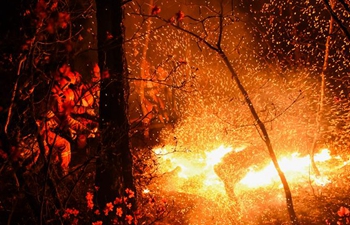CANBERRA, May 4 (Xinhua) -- Scientists from the Australian National University (ANU) have led a study which has solved the 168-year-old mystery of how some of the world's largest and most active volcanoes formed in Hawaii.
The Hawaiian volcanoes formed on "twin tracks" more than three million years ago, when a shift in the Pacific tectonic plate's direction separated the tracks, forming two distinct lines of volcanoes instead of the usual one, which occurs along fault lines.
Lead researcher and PhD student from the Australian National University Tim Jones said while scientists have been aware of the "twin volcanic tracks" phenomenon since 1849, the cause of them had remained a mystery for 168 years.
Jones said the discovery would help scientists further "reconstruct Earth's history and understand part of the world that has captivated people's imagination" for hundreds of years.
"The analysis we did on past Pacific plate motions is the first to reveal that there was a substantial change in motion 3 million years ago," Jones said in a statement on Thursday.
"It helps to explain the origin of Hawaii, Earth's biggest volcanic hot spot and one of the most popular tourist destinations in the world."
Jones said the kind of plate activity was surprising because it occurred away from tectonic plate boundaries where most volcanoes are found, while co-researcher Dr. Rhodri Davies said the "twin volcanic tracks" emerged because the "mantle plume" -- or hot columns of rock which force their way to the Earth's surface -- was out of alignment with the direction of the tectonic plate's motion.
"Our hypothesis predicts that the plate and the plume will realign again at some stage in the future, and the two tracks will merge to form a single track once again," Davies said.
"Plate shifts have been occurring constantly, but irregularly, throughout Earth's history. Looking further back in time we find that double tracks are not unique to young Hawaiian volcanism - indeed, they coincide with other past changes in plate motion."
















